This is mostly Kirk's foodblog. Sometimes Cathy blogs here too. Today's blog is by ed (from Yuma).
I was in SD on my own because Tina was stuck in Yuma working and taking care of our new, irresistibly cute rescue dog Chloe:
My plans were up in the air – so many enticing dining options that my mental palate couldn't decide.
Then right there on University just before I was going to turn left to get on the 163 going north, I spotted an Ethiopian restaurant, Bayu's:
So a decision happened. I remember my first Ethiopian restaurant about 30 years ago in Portland, Oregon. The exuberant and friendly owner told stories about diving for cover during World War II when the Italian fighter planes strafed his home village. He made it seem like a child's game. Between his stories and the food, it was a totally different restaurant experience.
And the food – the sourish gray pancake covered with a lamb shank stewed almost to disintegration in a dark and fiery sauce full of spices and flavors I had never encountered before. My mouth burned in a really good way.
In any case, I am still a sucker for Ethiopian food even though most other Ethiopian restaurants don't live up to my original memory (memory is like that sometimes).
Bayu's is a very clean and attractive space with tasteful decorations and pleasant Ethiopian music playing in the background: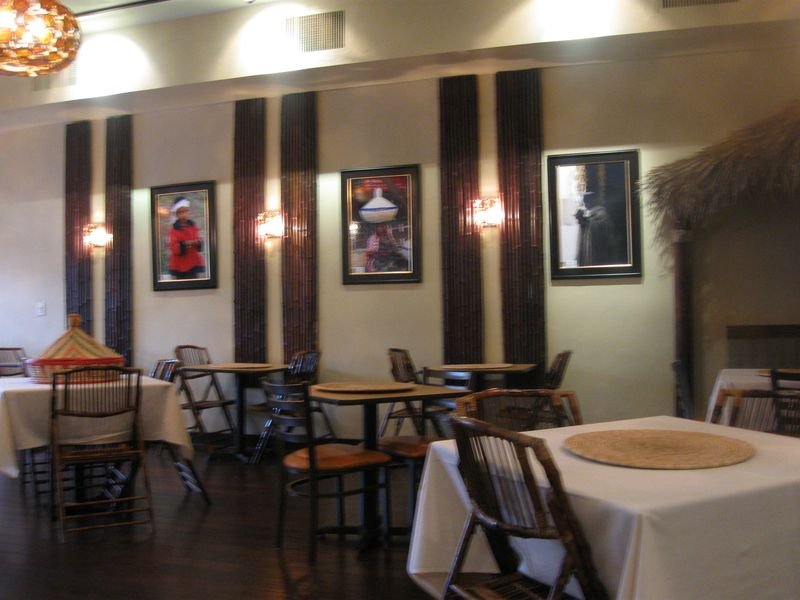
Upon entering, I was greeted by a friendly and pleasant hostess who would also be my server. While I quickly located a sampler platter on the menu, it was interesting to watch and listen as she explained the cuisine to some newbies – trying to be as accommodating to their requests and desires as possible.
I ordered the giant combination, called Taste of Bayu's. At $26.50, it was certainly the most expensive item I've ever ordered at an Ethiopian restaurant. What's more, the meal would be gigantic, more than I could possibly eat, but I could sample a range of this restaurant's dishes.
I also tried a bottle of Ethiopian beer, which the helpful young woman explained went well with Ethiopian food: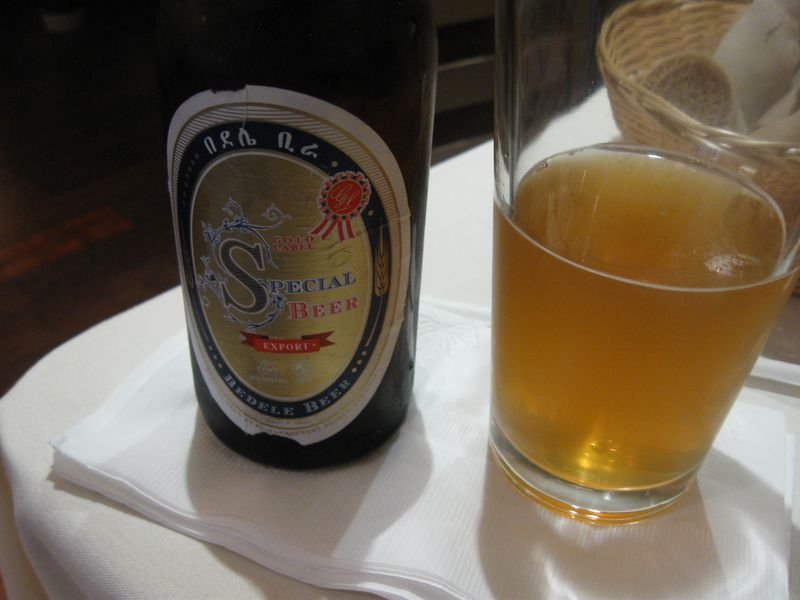
She was right. Although the beer by itself tasted rather sweet and bland, it paired nicely with the cuisine.
Before I describe the meal in more detail, I should explain about injera: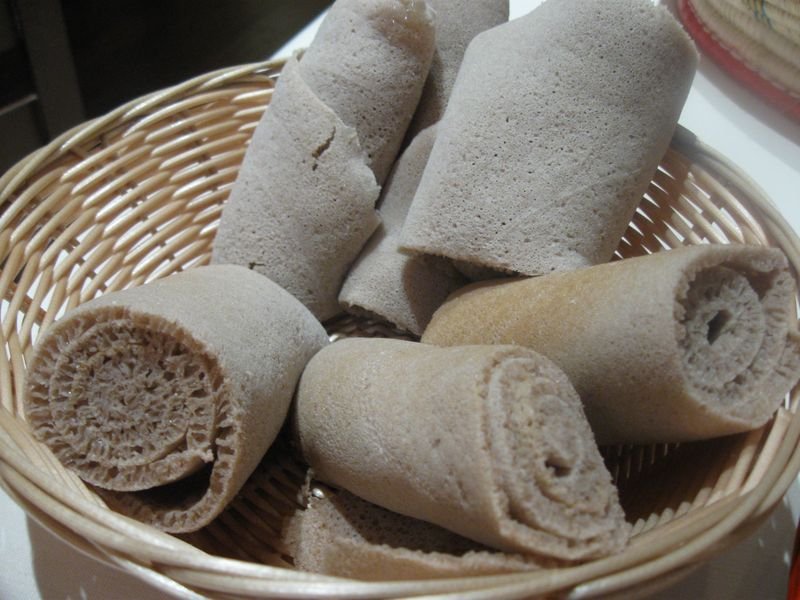
This is the national bread of Ethiopia. Is a fermented flatbread made from a grain called teff. This grassseed is gluten free so the bread does not rise. When the dough is placed on the flat grill, it bubbles like a pancake. Unlike a pancake, is not flipped over, so one side is flat and smooth and the other is like a sponge. The meal came with this basket full of cool injera rolled into cylinders (I have no idea why injera is never served heated).
But injera is not just a bread, not just a starch; it is also the main utensil. When eating Ethiopian food, you tear off a piece of injera and use it to scoop up your food and place it in your mouth. In addition, Ethiopian meals are presented on large round discs of injera. The bread then is knife, fork, and plate.
My order of Taste of Bayu's came to the table looking like this: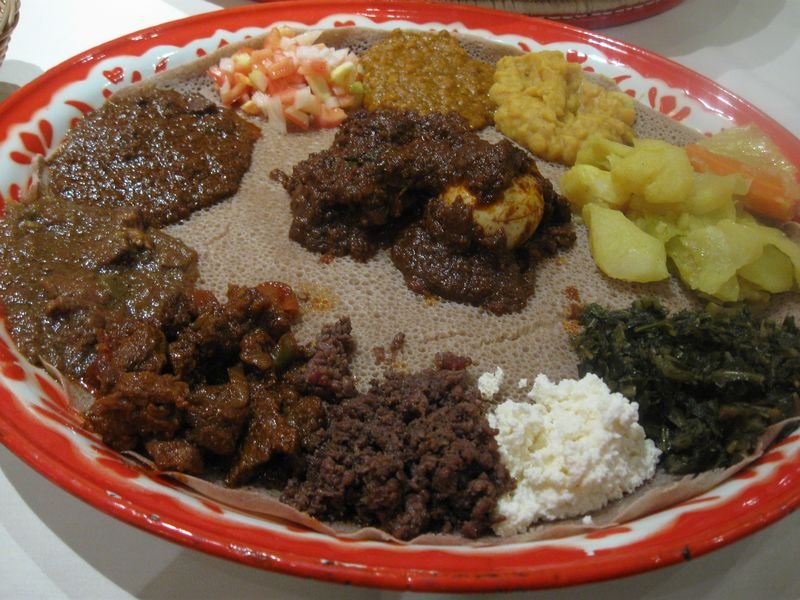
The meat dishes were on the left and center - the vegetarian dishes around the right side.
Best way to describe the meal is to proceed clockwise with additional pictures when they are helpful. Starting at 12 clock, we have misir wat, spicy lentil stew. I grew up eating lentils and almost never dislike a lentil dish. Here the flavorful pulse was enhanced by Ethiopian spices including ground dried chilies, giving the dish a nice moderate heat level.
Right next to the lentils was atakill, curried split peas. The pair of legumes presented a definite contrast in look and color: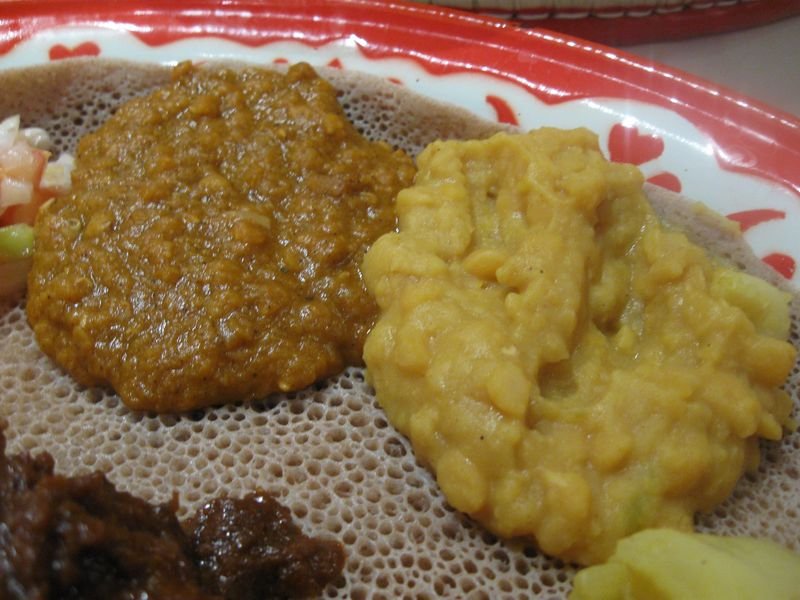
The contrast went deeper. The peas had a chewier texture and a robust and earthy flavor profile – with just a light kiss of curry spices.
The next item, atakik alech, was probably my least favorite of the night. Nothing wrong with it, but the potato/carrot/cabbage combo was plain and ordinary. Of course, if you like those basic flavors, you would think of this is a natural and straightforward presentation: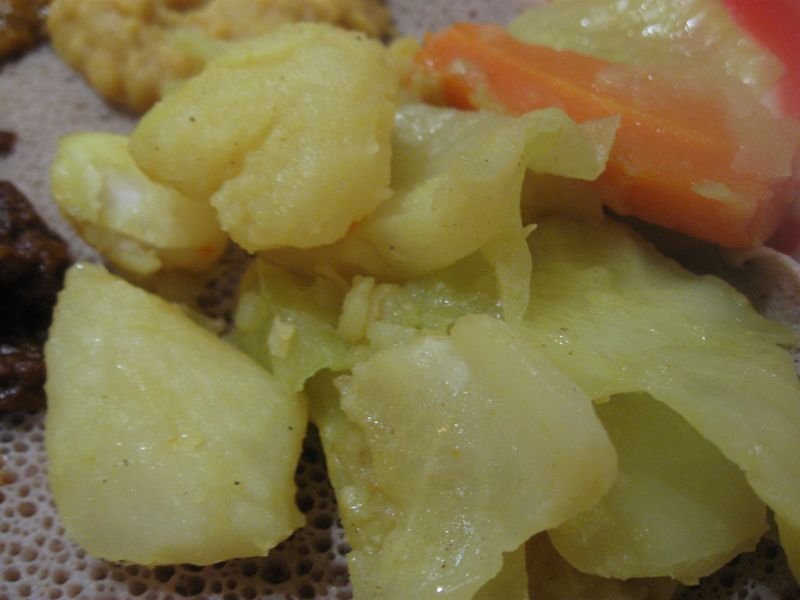
The three items between four o'clock and six o'clock are usually served together as special kitfo, and they did make a nice group of flavors, textures, and tastes: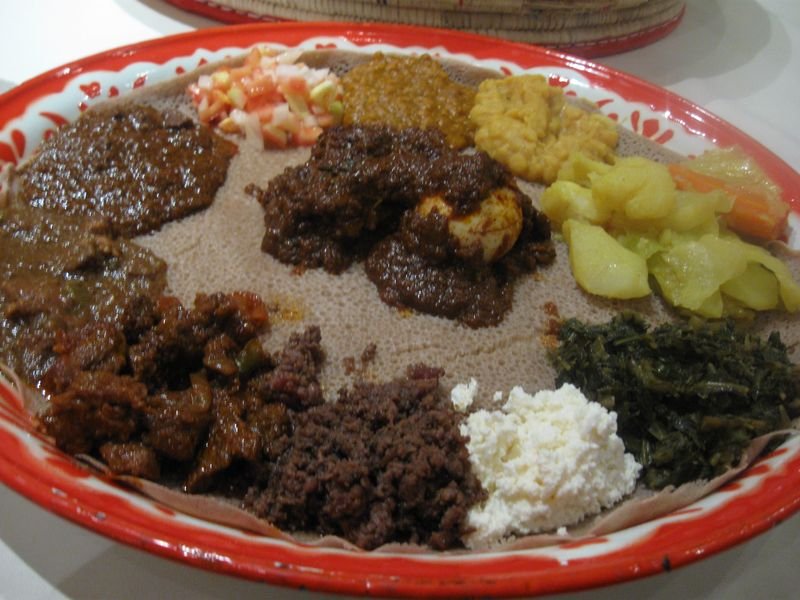
The meat was finely chopped beef cooked in butter. Its flavor was very meaty, though there was a touch of greasiness left on my tongue. On its right is ayib, translated Ethiopian cottage cheese on the menu. But in some ways it reminded me more of a cotija or perhaps a feta, drier and saltier than most conventional American cottage cheeses. The greens, gomen, are chopped and stewed collards. Minimally spiced, they were nicely prepared – not overcooked at all. The flavor of the collards spoke spoke to me without an interpreter. While each of these three items was uniquely itself, they complemented each other well. One intensely meaty, one simply cheesy, and one greenly vegetal. I understand why they are often served together.
The next item – to the left of the kitfo – was one of my favorites that evening. Called sega tibs, it is a complexly spiced rich beef stew, each chunk still having some chew and a lot of beef flavors. It deserves a close-up: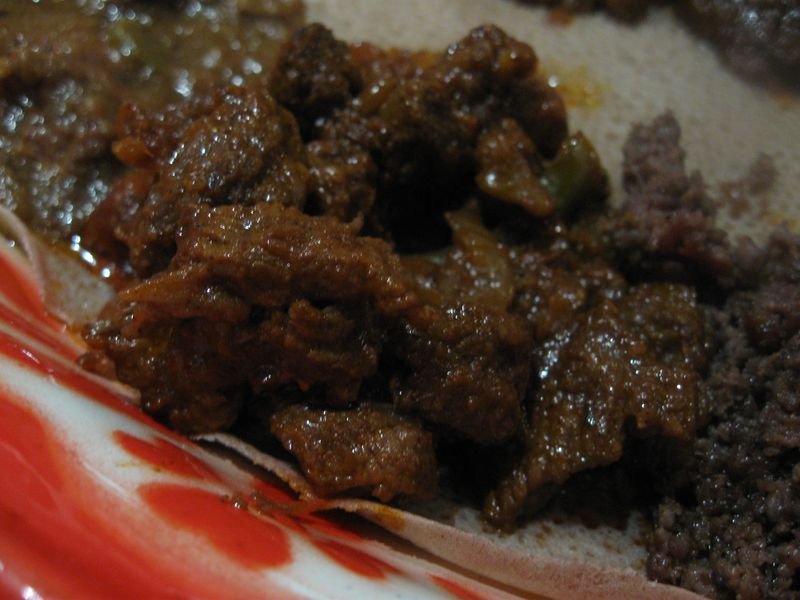
The next two items were sega wat (spicy beef stew) and yebeg alecha (mild lamb stew). In contrast with the tibs, both of these meats were cooked to a soft stewed texture.
The central item on the plate was doro wat or spicy stewed chicken with boiled egg: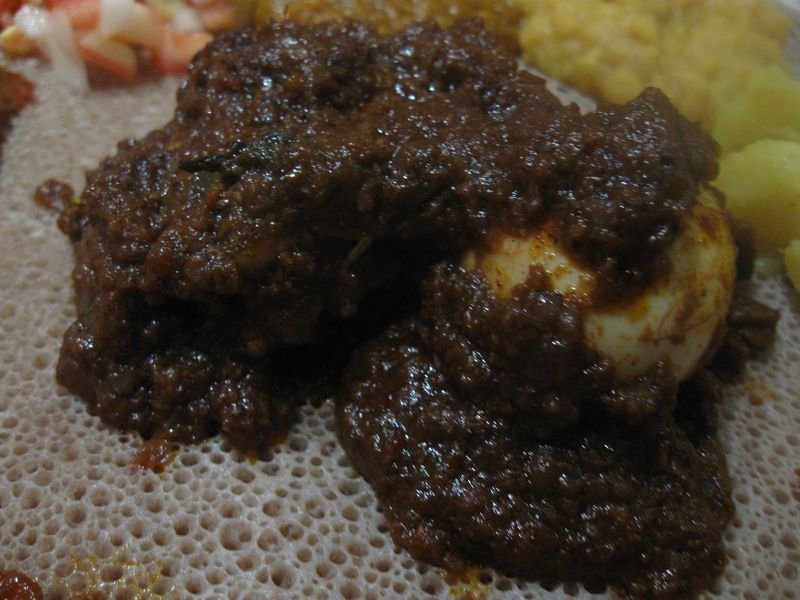
This centerpiece was a little disappointing to me. There seem to be as much boiled egg as chicken. And the sauce, while flavorful, wasn't as intense or as fiery as I have had other places. To be fair, one poster at Yelp complained that the chicken stew was inedibly hot, so maybe Bayu's has toned things down a bit since then.
For me, the tomato salad sort of thing at the top of the platter was extremely successful: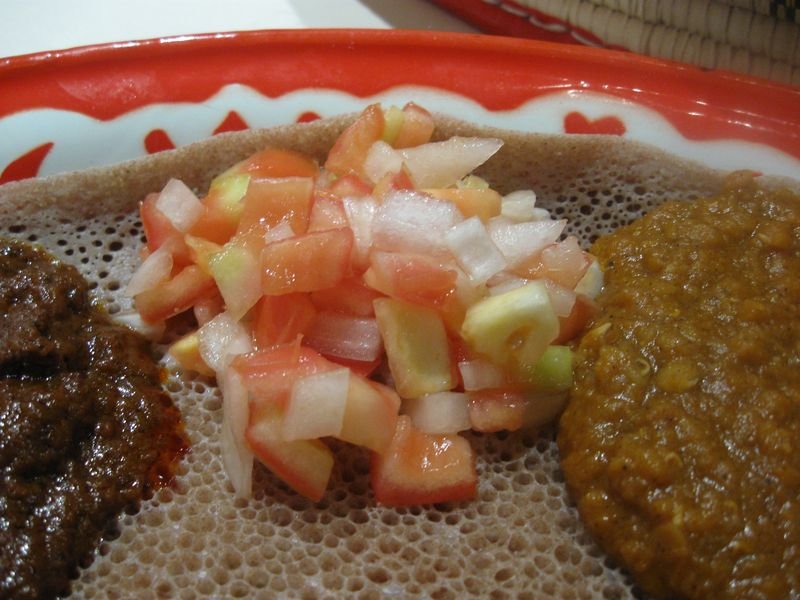
While some sort of salad is usually included in Ethiopian combination plates, those salads are often bland combinations of chopped lettuce and tomato. Here, however, the diced onions and tomato had been tossed with some sort of vinegar, making the salad an excellent and tangy palate cleanser. I loved it.
One great thing about Ethiopian food is that the injera on which the dishes are served soaks up sauces and juices throughout the meal: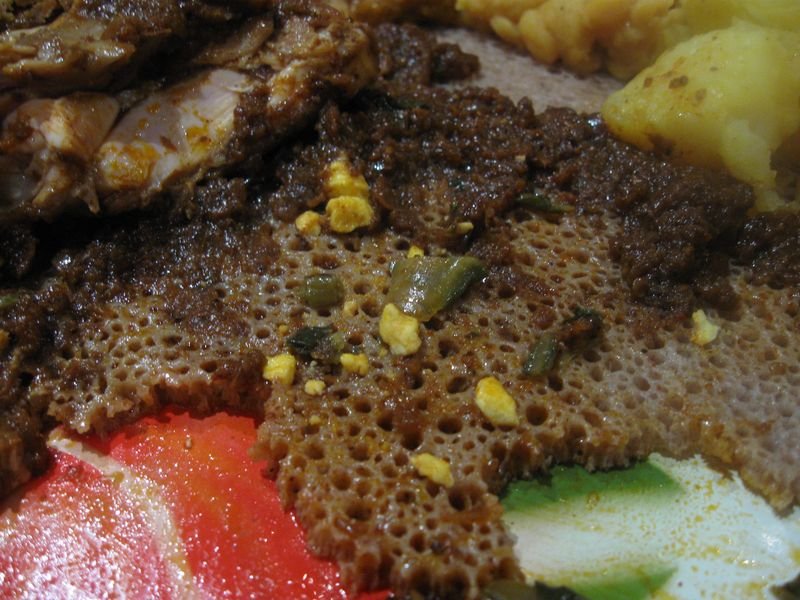
While you can use pieces of the separate rolled injera to pick up morsels of meat and vegetables, I prefer to use the injera on which the items are served. While that is certainly the messier option, it is also the juicier option. And I am not embarrassed to lick my fingers, particularly when they taste this good.
Overall, my experience at Bayu's was a positive one. I would happily return. The atmosphere and service were excellent. While it would have been nice to have some berbere paste available on the platter or on the side to add fire, the spicing was generally satisfactory and complex. It would also be interesting to try some of the dishes that are not on the combination plate, like creamy tasting shiro (ground peas), a different lamb dish (spicy stew or lamb tibs) or even gored gored, a raw beef dish. Because of the friendly and helpful service, Bayu's would also be a good restaurant for folks unfamiliar with Ethiopian cuisine.
Bayu's Authentic Ethiopian, 530 University Avenue, San Diego, CA 92103, (619) 546-0540.